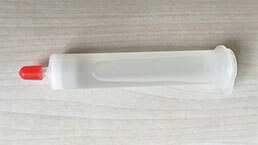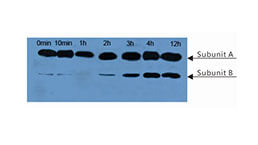Biotin-Linked Polyclonal Antibody to Asymmetrical Dimethylarginine (ADMA) 

N,N-Dimethylarginine; NG,NG-Dimethylarginine dihydrochloride; Asymmetric Dimethylarginine
- UOM
- FOB US$ 131.00 US$ 306.00 US$ 437.00 US$ 1,093.00 US$ 4,370.00
- Quantity
Overview
Properties
- Product No.LAB301Ge71
- Organism SpeciesPan-species (General) Same name, Different species.
- ApplicationsWB; IHC; ICC.If the antibody is used in flow cytometry, please check FCM antibodies.
Research use only - DownloadInstruction Manual
- CategoryMetabolic pathwayCardiovascular biology
- SourceAntibody labeling
- Ig Type IgG, Potency n/a
- PurificationAntigen-specific affinity chromatography followed by Protein A affinity chromatography
- LabelBiotin
- Original Antibody PAB301Ge01-Polyclonal Antibody to Asymmetrical Dimethylarginine (ADMA)
- Buffer FormulationPBS, pH7.4, containing 0.02% NaN3, 50% glycerol.
- TraitsLiquid, Concentration 500µg/mL
Sign into your account
Share a new citation as an author
Upload your experimental result
Review

Contact us
Please fill in the blank.
Specifity
The antibody is a rabbit polyclonal antibody raised against ADMA. It has been selected for its ability to recognize ADMA in immunohistochemical staining and western blotting.
Usage
Western blotting: 0.5-2ug/ml
Immunocytochemistry in formalin fixed cells: 5-20ug/ml
Immunohistochemistry in formalin fixed frozen section: 5-20ug/ml
Immunohistochemistry in paraffin section: 5-20ug/ml
Enzyme-linked Immunosorbent Assay: 0.05-2ug/ml
Optimal working dilutions must be determined by end user.
Storage
Store at 4°C for frequent use. Stored at -20°C in a manual defrost freezer for two year without detectable loss of activity. Avoid repeated freeze-thaw cycles.
Stability
The thermal stability is described by the loss rate. The loss rate was determined by accelerated thermal degradation test, that is, incubate the protein at 37°C for 48h, and no obvious degradation and precipitation were observed. The loss rate is less than 5% within the expiration date under appropriate storage condition.
Organism Species More: Pan-species (General)Giveaways
Increment services
Citations
- Interactions among Vascular-Tone Modulators Contribute to High Altitude Pulmonary Edema and Augmented Vasoreactivity in HighlandersPubMed: PMC3439466
- Effect of CCL5 on dimethylarginine dimethylaminohydrolase-1 production in vascular smooth muscle cells from spontaneously hypertensive rats.Pubmed: 23834755
- Effect of 18β-glycyrrhetinic acid on cerebral vasospasm caused by asymmetric dimethylarginine after experimental subarachnoid hemorrhage in rats.Pubmed:25475507
- Correlation research on ADMA plasma levels and left ventricular function of peritoneal dialysis patientsPubmed:25550968
- Asymmetric dimethylarginine contributes to airway nitric oxide deficiency in patients with COPDPubMed: 26076870
- Dimethylarginine dimethylaminohydrolase-1 mediates inhibitory effect of interleukin-10 on angiotensin II-induced hypertensive effects in vascular smooth muscle cells of spontaneously hypertensive ratsPubMed: 26375520
- Effect of 18β-glycyrrhetinic acid on cerebral vasospasm caused by asymmetric dimethylarginine after experimental subarachnoid hemorrhage in ratsPubMed: 25475507
- Dimethylarginine Dimethylaminohydrolase 2 (DDAH 2) Gene Polymorphism, Asymmetric Dimethylarginine (ADMA) Concentrations, and Risk of Coronary Artery Disease: A Case-Control Studypubmed:27677852
- Increased serum concentrations of asymmetric dimethylarginine (ADMA) in patients with early-onset coronary artery disease.pubmed:27884754
- Asymmetric dimethylarginine (ADMA) elevation and arginase up-regulation contribute toendothelial dysfunction related to insulin resistance in rats and morbidly obese humans.pubmed:26840628
- Dimethylarginine dimethylaminohydrolase-1 (DDAH1) is frequently upregulated in prostate cancer, and its overexpression conveys tumor growth and angiogenesis by metabolizing asymmetric dimethylarginine (ADMA).pubmed:29150732
- A Novel Role of Irbesartan in Gastroprotection against Indomethacin-Induced Gastric Injury in Rats: Targeting DDAH/ADMA and EGFR/ERK SignalingPubmed:29523851
- Multivessel analysis of progressive vascular aging in the rat: Asynchronous vulnerability among vascular territoriesPubmed:29605639
- Arginine bioavailability and endothelin-1 system in the regulation of vascular function of umbilical vein endothelial cells from intrauterine growth restricted newbornsDoi: 10.1016/j.numecd.2018.09.002
- Probucol improves erectile function via Activation of Nrf2 and coordinates the HO-1/DDAH/PPAR-γ/eNOS pathways in streptozotocin-induced diabetic ratsPubmed: 30454888
- Demographic, clinical and lifestyle predictors for severity of erectile dysfunction and biomarkers level in Malaysian patients
- Novel cellularly active inhibitor regresses DDAH1 induced prostate tumor growth by restraining tumor angiogenesis through targeting DDAH1/ADMA/NOS pathwayPubmed: 30673277
- Nebivolol prevents the increase of asymmetric dimethylarginine and oxidants in hyperhomocysteinemic rats
- The Role of Reactive Oxygen Species and Nitric Oxide in the Inhibition of Trichophyton rubrum Growth by HaCaT CellsPubmed: 32104540
- Blueberry anthocyanin‑enriched extract ameliorates transverse aortic constriction‑induced myocardial dysfunction via the DDAH1/ADMA/NO signaling pathway in …Pubmed: 31746378
- Effect of a Supervised Peridialytic Exercise Program on Serum Asymmetric Dimethylarginine in Maintenance Hemodialysis PatientsPubmed: 33163233
- The Usefulness of Serum Biomarkers in the Early Stages of Diabetic Retinopathy: Results of the EUROCONDOR Clinical TrialPubmed: 32344735
- Levels of endothelial substances in patients with newly identified hypertension compared with healthy controls33463628
- Non-functioning adrenal incidentalomas may increase toxic metabolites34255169
- Effect of a Low Dose of Carvedilol on Cyclophosphamide-Induced Urinary Toxicity in Rats—A Comparison with Mesna34959638
- HIF-1α and Nrf2 regulates hypoxia induced overexpression of DDAH1 through promoter activation in prostate cancerPubmed:35644470







